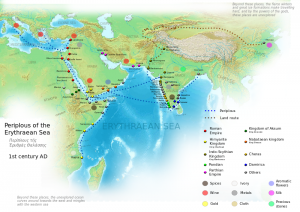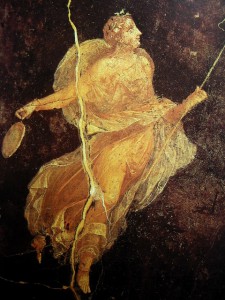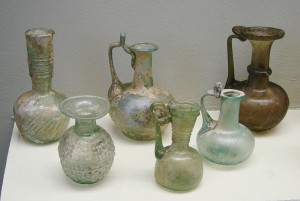Ancient Rome & China: Five Examples of their Relationship Posted by Brittany Britanniae on Feb 26, 2015 in Roman culture
In honor of Chinese New Year or Lunar New Year (February 19th), I wanted to write a post on the relations between Ancient Rome and China. I did not want to examine the minute details for the expert scholar, but rather provide a survey or summary of my research for anyone that was curious about the two empires and their communication.
CHINA AND ROME
In classical sources, the problem of identifying references to ancient China is tied to the interpretation of the Latin term “Seres,” whose meaning could refer to a number of Asian people in a wide arc from India over Central Asia to China. In Chinese records, the Roman Empire came to be known as “Da Qin”, Great Qin, apparently thought to be a sort of counter-China at the other end of the world. For ancient China, the Roman Empire would have been a great ally in trade and commerce, but at the same time would be a difficult acceptance due to Chinese mythological notions about the far west.

The trade relations between Rome and the East, including China, according to the 1st century BC navigation guide Periplus of the Erythraean Sea. Courtesy of George Tsiagalakis / CC-BY-SA-4 licence
1. SILKS
Trade with the Roman Empire, confirmed by the Roman craze for silk, started in the 1st century BCE.
Pliny the Elder wrote about the large value of the trade between Rome and Eastern countries:
“By the lowest reckoning, India, Seres and the Arabian peninsula take from our Empire 100 millions of sesterces every year: that is how much our luxuries and women cost us.”
—Pliny the Elder, Natural History 12.84.
Even the rest of the nations of the world which were not subject to the imperial sway were sensible of its grandeur, and looked with reverence to the Roman people, the great conqueror of nations. Thus even Scythians and Sarmatians sent envoys to seek the friendship of Rome. Nay, the Seres came likewise, and the Indians who dwelt beneath the vertical sun, bringing presents of precious stones and pearls and elephants, but thinking all of less moment than the vastness of the journey which they had undertaken, and which they said had occupied four years. In truth it needed but to look at their complexion to see that they were people of another world than ours.
Its territory extends for several thousands of li [a li during the Han equaled 415.8 metres],They have established postal relays at intervals, which are all plastered and whitewashed. There are pines and cypresses, as well as trees and plants of all kinds. It has more than four hundred walled towns. There are several tens of smaller dependent kingdoms. The walls of the towns are made of stone.4.

Build vocabulary, practice pronunciation, and more with Transparent Language Online. Available anytime, anywhere, on any device.
About the Author: Brittany Britanniae
Hello There! Please feel free to ask me anything about Latin Grammar, Syntax, or the Ancient World.




![Coin minted by Augustus (c. 19–18 BC); Obverse: CAESAR AVGVSTVS, laureate head right/Reverse: DIVVS IVLIV[S], with comet (star) of eight rays, tail upward. Courtesy of Classical Numismatic Group, Inc. and Wikicommons](https://blogs.transparent.com/latin/wp-content/uploads/sites/15/2015/02/S0484.4-300x147.jpg)
![The Chinese impression of the Daqin people, from the Ming Dynasty encyclopedia Sancai Tuhui. Courtesy of Wikicommons. [Daqin was the Chinese word for Roman Empire.]](https://blogs.transparent.com/latin/wp-content/uploads/sites/15/2015/02/Daqin_in_Sancai_Tuhui-200x300.jpg)

